Building a League of Trees
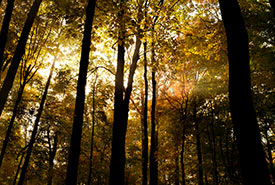
Happy Valley Forest (Photo by NCC)
Climate change superheroes
Trees are the frontline heroes fighting climate change every day. They sequester CO2, act as buffers against floods from changing precipitation patterns and help reduce erosion caused by increased storm events.
The Nature Conservancy of Canada (NCC), LEAF, Bruce Trail Conservancy and Ontario Power Generation (OPG) have banded together to protect and expand Ontario’s League of Trees.
In Ontario, the League of Trees is made up of 85 billion trees. Some of them live in forests, some live in parks, some even in your backyard. Wherever trees are, they are always working.
NCC protects and stewards more than 13,800 hectares (34,100 acres) of forests in Ontario — from the edge of the boreal forest in the north, to the Carolinian forest in the far south.
How trees help our climate
From taking pollutants out of the atmosphere, to producing clean oxygen to breathe, to creating habitats and battling extreme weather, trees are essential to climate change mitigation. They can:
- help prevent flooding by absorbing water through their roots and slowing rainfall with their branches and leaves;
- provide habitat for many species;
- remove 85 kilograms of air pollution throughout their lifetime; and
- store approximately 6,385 kilograms of carbon dioxide throughout their lifetime.
Did you know: An acre of mature trees can absorb the same amount of CO2 produced as when you drive your car 26,000 miles.
What NCC is doing to protect Ontario’s forests
In Ontario we’ve been very lucky to have an abundance of forests. Yet globally, forests are disappearing. That’s why NCC is acting now, to protect the last and best of our forests. We have the opportunity to be an example to the world. And fortunately, there are groups, like LEAF, Bruce Trail Conservancy and OPG, that believe in the importance of protecting these places for the future.
In Ontario, we work to protect and restore forests throughout the province. Here are just some of the areas we’re working in:
Maitland River Valley
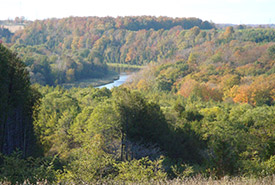
Fall colours along the Maitland River (Photo by NCC)
Thanks to the support of OPG, NCC is working to grow our League of Trees in the Maitland River Valley. NCC staff and volunteers will be planting trees on former agricultural fields in this natural area near Godrich, Ontario.
We will be planting over 29,000 trees over the next few years. Species include red maple, silver maple, downy serviceberry, yellow birch, paper birch, hackberry, black walnut, bur oak, red oak, American elderberry, eastern white cedar, American basswood and nannyberry.
By increasing native biodiversity on former agricultural fields, this direct climate action helps to sequester carbon, reduce erosion and nutrient loading into nearby creeks and creates habitat for wildlife. Trees including native oaks and maples can absorb up to 50 litres of water per day. Our native oaks in particular support the larvae of more than 500 butterfly and moth species, which provide the essential insect protein for hatchling birds: a natural bird feeder! Protected natural areas like the Maitland River Valley are part of the nature-based solutions that are helping to provide refuge for species at risk in Ontario and create a diverse landscape that is more resilient to a changing climate.
Happy Valley Forest
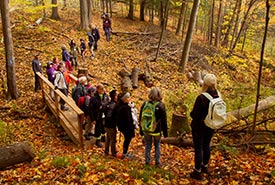
Hike in Happy Valley Forest, ON (Photo by NCC)
Happy Valley Forest is the largest intact block of deciduous forest on the Oak Ridges Moraine. It is an outstanding example of a mature sugar maple and beech upland forest. Located in King Township, this old-growth forest in the making supports at least 30 species listed as at risk by the Committee on the Status of Endangered Wildlife in Canada and 29 provincially listed species at risk.
With mounting residential and industrial pressures throughout the Greater Toronto Area, it is critical that we conserve local forests so that they can continue to clean our air, filter our water, and provide opportunities for residents to connect with nature. To date, NCC and our partners have protected 356 hectares (880 acres) at the core of the Happy Valley Forest. It is our goal to protect even more of this important natural area, and manage it for the long term.
Frontenac Arch
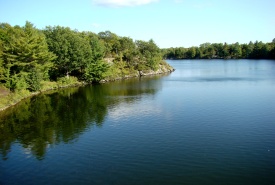
Elbow Lake, Frontenac Arch, ON (Photo by NCC)
Connecting the northern forests of the Algonquin Highlands with the Adirondack Mountains in New York state, the Frontenac Arch forms a critical habitat linkage between the northern hardwood and mixed forests of Ontario and the Appalachian Mountain chain of eastern North America. This narrow bridge is in one of the most important forest corridors east of the Rocky Mountains.
The Frontenac Arch is a confluence of five different forest regions, bringing together the northern Canadian Shield forests and southern Carolinian influences. This unique overlap creates a great richness of plant, insect and animal species, making it one of the most biodiverse regions in Canada and a place of great beauty. Over 200 bird species alone have been recorded at the Queen’s University Biological Station inside the Frontenac Arch.
To date, NCC and our partners have helped to protect more than 4,770 hectares (almost 11,800 acres) in the Frontenac Arch.
Backus Woods
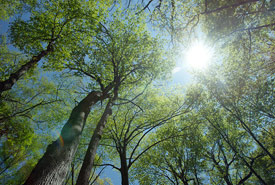
The breathtaking Backus Woods in Ontario. One of the best examples of Carolinian old-growth forest in the country. (Photo by Ann Tipper and Zach Melnick)
In southwestern Ontario’s Norfolk County lies an incredible natural oasis known as Backus Woods. This spectacular older-growth forest is home to some of the oldest living trees in Ontario and is one of the best remaining examples of Carolinian forest in Canada. A haven for species at risk, Backus Woods provides important habitat for prothonotary and cerulean warblers, Louisiana waterthrush, eastern foxsnake, Blanding’s turtle and Jefferson salamander.
Old-growth forests provide key functions in the ecosystem. They are important habitat for plants and animals, sequester carbon, protect streams that provide clean drinking water, and more. Old-growth forests also act as a reservoir for biodiversity.
To date, NCC has protected 817 hectares (2,020 acres) of forest, wetland and restored fields in and around Backus Woods.
What you can do to help grow Ontario’s League of Trees
Watch and share the League of Trees video using the hashtag #leagueoftrees




